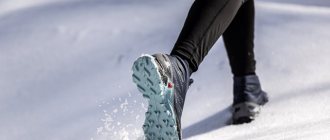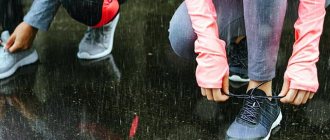- Running clothes in autumn: 5 basic rules
- How to dress for running in the fall: temperature, pace, wind and precipitation, safety
- Running shoes for autumn
- Signets and hat for running in autumn
- Video about running in autumn
Autumn is the ideal time for running and personal bests: there is no sweltering heat, and the winter cold is still far away. This is why most major marathons take place closer to autumn. However, you often have to train in rain or strong winds. As you know, there is no bad weather for running, only bad equipment. We have collected the basic rules of equipment for running outside in the fall, and suggested what to wear in different weather conditions.
Is it possible to run outside in autumn and winter?
It’s not just possible, but necessary. With the onset of cold weather, the risk of colds increases, so it is necessary to support the body with moderate physical activity. You shouldn't strive to break records or complete ultramarathons in low temperatures and heavy rain, but an hour of running at an easy pace is enough exercise to maintain your fitness and immunity.
Fall is the perfect time to start running if you haven't already joined the running community. There is no sweltering summer heat, and there is enough time before the first spring races to get in shape. In the spring, when the snow melts and the sun begins to warm up, the legs themselves will run faster due to the base laid in the cold season.
What clothes should you wear to run outside in the fall?
In autumn, especially late autumn, it is important to follow the principle of multi-layered clothing - the main rule for keeping the body dry and warm. Depending on the air temperature and humidity, the number of layers may vary, but in any case it is recommended to use the following sequence:
- Base layer. It is best to use thermal underwear as a base layer that is in contact with the body. It wicks away sweat perfectly and keeps the skin dry. If the temperatures outside are still above zero and there is no reason to wear a lot of insulation, you can use a synthetic T-shirt or long sleeve.
- Intermediate layer. The middle layer should retain the heat generated by the body while running. Its role is ideally performed by fleece products. If the air temperature is still significantly above zero, then the intermediate layer can be neglected.
- Upper layer. The outer layer protects from wind and moisture. Since autumn is a time of changeable weather conditions, a top layer is essential. In dry weather, you can use a tracksuit jacket or a fleece jacket; in windy and rainy weather, a membrane jacket or windbreaker.
Try to avoid cotton items. They do not wick away sweat well and retain moisture, making them heavy and chafing. Also, if you stop while running in cotton clothes, you will freeze very quickly.
Since the legs do most of the work when running, they do not require the same insulation as the upper body. In the above-zero temperatures in the fall, you can run in tights or sweatpants; with the onset of cold weather, you can wear the pant legs from the thermal underwear set under the bottom. There are also insulated tights with fleece lining on the inside of the legs.
Socks in the fall should completely cover the ankles and not leave any exposed skin. In cold weather and when running long distances, some people choose to wear compression gaiters for added protection to their calf muscles. With the onset of negative temperatures, it is worth taking a closer look at sock models with a denser weave.
Running hats are also lightweight and denser: they are made of polyester, which wicks moisture well and prevents your head from sweating. Winter models have a fleece lining. The main thing you should pay attention to is that the hat should completely cover your ears, especially in windy weather.
A buff, also known as a sports scarf made of synthetic materials, is an excellent solution to cover your neck in windy and cold weather. Thanks to lightweight and breathable fabrics, the buff will not retain moisture and will keep you dry. Winter options are made from fleece.
Gloves for running in dry, cool weather are made of polyester, breathe well and do not allow your hands to sweat. Many modern models include finger pads to allow you to operate a touchscreen phone without removing your gloves. In wet and cold weather, it is better to run in winter models with insulation and a waterproof top layer or impregnation.
Although the sun is not common in autumn and winter, especially in northern latitudes, running glasses will protect your eyes from wind and rain, and in winter from snowstorms. There are solutions with interchangeable glasses, so you can choose lenses for specific conditions:
- dark and polarized - for protection from the sun and bright glare from snow;
- orange and yellow - to improve clarity during fog and snowfall;
- transparent - for running in the dark.
What to look for when choosing thermal underwear?
Important aspects:
- The most important thing for thermal underwear is the composition, not the manufacturer. For active sports (running, skiing, snowboarding), you need to select restorative double-layer thermal underwear. The bottom layer will be synthetic, and the top layer will be mixed, that is, contain both natural and artificial fabrics. For summer and spring-autumn jogging, you need to select thin synthetic underwear. Such things will not overheat the body. For participation in competitions and long races, thin synthetic underwear made of elastane or polyester is suitable. We have already mentioned the size - the skin should fit tightly, without any sagging.
- Regarding the seams, they should all be flat; existing tags and labels should also be placed on the outer surface.
- You need to decide the purpose of wearing underwear. There are 4 gradations of linen warmth: silk, medium, heavy and polarweight. The first two categories are quite suitable for snowboarding, cross-country skiing and jogging. The latter are only for those cases when you need to spend a lot of time in the cold. For example, for winter fishing or spending the night in a tent in the snow.
Running shoes for autumn
Autumn can be different: warm and cold, dry and wet, sunny and snowy. Choosing running shoes at this time of year is a particular headache for all runners, since it is important to ensure traction on any surface, even wet and slushy, especially during speed training. When choosing sneakers, it is recommended to focus on the following points:
- In dry and warm weather, you can continue to run in summer sneakers.
- In dry and cool weather, change your summer socks to warmer ones or buy sneakers with a denser mesh weave.
- In wet weather, sneakers with a tight weave or models with special impregnation are also suitable.
- When running on rough terrain and the first snow, it is better to change into sneakers with an aggressive tread (trail models). If there is slush or deep snow outside, sneakers with a membrane are suitable.
- If you continue to run even in severe frosts and ice, take a closer look at sneakers with spikes. They will provide the proper level of grip even on ice.
What sneakers to run in in the fall? Top 10 models for different weather conditions and tasks
Rules for warming up before jogging
If in the summer the warm-up can be done quickly and outdoors, then after the onset of cold weather the tactics will have to be changed somewhat. The duration of the warm-up should increase to 15-20 minutes, and it should be done at home so that you can run outside with your muscles already warmed up and your breathing adjusted to running. It is worth mentioning that a common problem when running is pain in the sides. Warm-up is needed just to avoid discomfort. There is an outflow of blood from the internal organs and an influx to the heated muscles.
The benefits and harms of running in autumn
There is a proven relationship between the intensity and duration of running and the functioning of the immune system: moderate exercise strengthens the immune system. For most recreational runners, this means an hour of running at a moderate pace.
Running 15 km or more, as well as intense exercise in cold weather, can temporarily weaken the immune system. This disruption of immune function usually lasts only a few hours, but it is during these hours that the body is at risk of disease. For this reason, marathon runners are six times more likely to get a cold after a race than during the training process.
Running in the fall and winter on unstable surfaces such as mud, loose soil and snow helps strengthen your feet by engaging stabilizer muscles. The main thing is not to focus on the pace numbers that you have become accustomed to over the summer, otherwise in pursuit of peak results the risk of injury will increase.
How to run in the fall to avoid getting sick
In the fall, it is necessary to adjust your training habits and adhere to certain rules to reduce the likelihood of illness:
- You need to dress a little lighter for running outside than if you were just going out for a walk. Keep in mind that while running, your body temperature rises and sweating increases. Layers should work and do their job, not overheat you.
- Do a good warm-up before an intense run. Because of the cold, muscles and ligaments can stiffen (they become less elastic and are more easily injured during acceleration), so first jog, warm up, do joint warm-ups and dynamic stretching. And only then move on to the main training.
- Reduce the volume and intensity of your running. Late autumn and winter are not the best time for records. It’s better to keep in shape without injury or illness and then improve in the spring than to lie on the couch all winter due to the whims of the body. Also, autumn and winter are great for strength training in the gym and working on weak points: pump up muscles, strengthen ligaments and tendons, work on joint mobility.
- In cold weather, avoid speed and interval training. During fast periods, you will become very overheated, which is why your body will freeze during rest intervals. It is better to do quick training in the arena.
- Adjust your diet and monitor your water consumption. In the fall, it is more difficult to buy seasonal summer vegetables and fruits, so you need to keep your diet balanced. In cold weather, you may also find that you don't need as much water as you do in the summer. In fact, due to low temperatures, you simply cool down faster, but you also continue to lose fluid through sweat. Stay hydrated to avoid dehydration, especially during long runs.
- Do not run while sick, and after recovery, start with easy, short runs. After suffering from an illness, you must adhere to the same principle of gradualness as if you were starting to run from scratch.
More about running, training, nutrition, sports medicine and sports as an activity - in the “Health” section
Subscribe to the Sports.ru telegram channel about health
Photo: unsplash.com/Emma Simpson, Jenny Hill, Alesia Kazantceva, Karmishth Tandel; pexels.com/Andre Morgan, Tembela Bohle
First layer
At temperatures below +10℃, we recommend putting aside the summer set consisting of a T-shirt with shorts, and using long sleeves and tights as the first layer. They should be made of elastic, lightweight, breathable materials, such as sports synthetics. It is important that this part of the equipment fits the body, but does not restrict movement.
By the way, if for aesthetic reasons you are uncomfortable running in tights alone, then you can wear running shorts over them. They will not only relieve you from embarrassment, but will also serve as additional insulation.
For those who like to run in frosty weather, we advise you to think about insulated tights. They can usually be distinguished by a dense insert on the front surface of the leg. If necessary, you can wear thermal underwear underneath.
Best posts about running
- Half Marathon Training Plan - Weekly Plan for Beginners
- Is it possible to run outside in winter?
- Running on asphalt is harmful! Or not? Let's look at how grass, soil, sand, concrete and stadium surfaces affect running
- How to run a long workout? Runner and Coach Tips
- I run almost every day, but I'm not losing weight. What am I doing wrong?
- Is it true that running outside is healthier than running in the gym?











